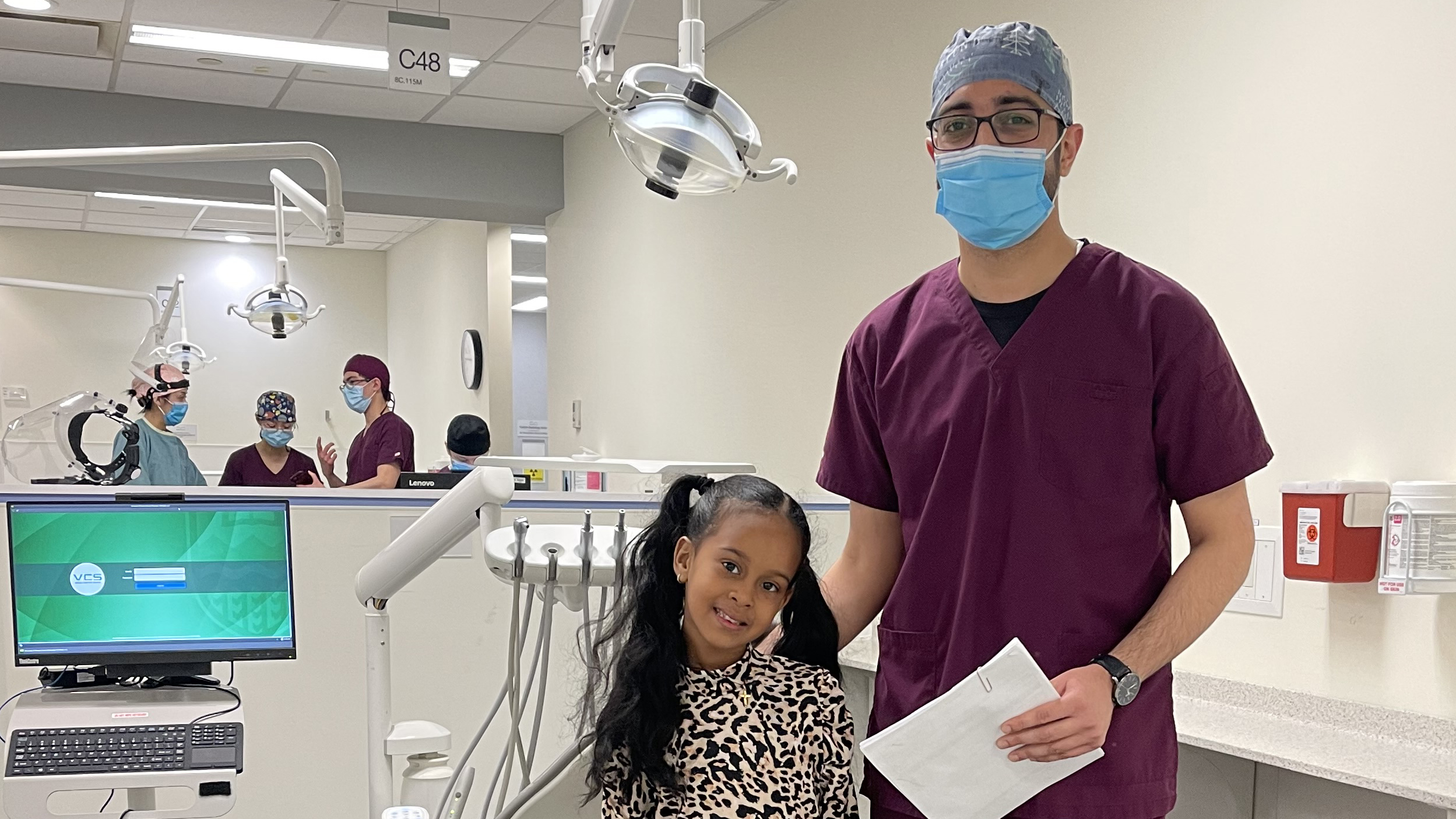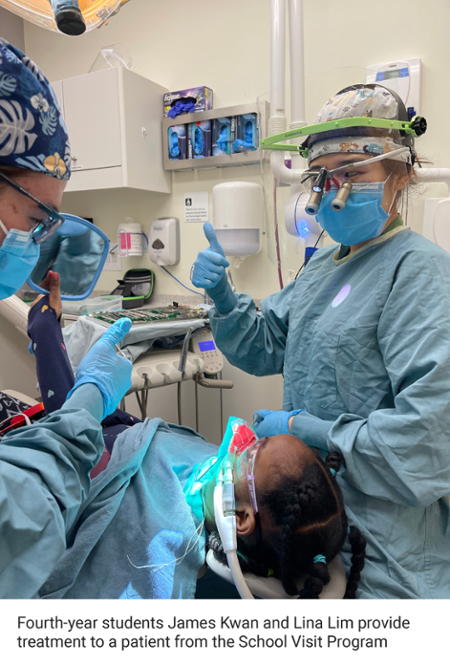Pediatric Dentistry at the University of Alberta is making a big difference in the lives of underserved children and their families
Shirley Wilfong-Pritchard - 18 April 2023

Third-year DDS student Gagandeep Dosanjh with a patient from the School Visit Program
No one stops for dinner; there’s no time. By 8:30 p.m. the group has examined 90 children, viewed 90 medical charts on five computers, talked to dozens of parents, often through a translator, and triaged which children — based on the most urgent dental needs — will be offered free pediatric dentistry services, performed by supervised students from the School of Dentistry.
How it works
The School Visit Program’s success is due to the collaboration between the School of Dentistry, Alberta Health Services (AHS), and the Edmonton public and Catholic school boards, all of whom have the same goal: to create equitable access to oral health care for children from underserved areas.Each year, AHS identifies five or six schools in Edmonton where children have the greatest oral-health needs. The AHS Public Health team first visits each school to teach children in kindergarten and grades 1 and 2 about nutrition and oral health; the team also performs sealant procedures and screens the children for other dental issues and diseases. AHS then liaises with the Pediatric Dentistry program.
Pediatric Dentistry provides the schools with a letter for each child describing the School Visit Program. Interested families are invited to register their child and attend the parent information session at their child’s school, where the team makes sure the parents have a solid understanding of their child’s dental issues and possible treatment. Accompanied by a teacher, the children are bussed to and from the Oral Health Clinic. The first of four or five visits consists of a complete dental examination, including x-rays, and a personalized treatment plan. Parental consent is obtained throughout every step of the process.
More than 200 children will be referred to Pediatric Dentistry through the School Visit Program each year, amounting to 450-plus appointments and close to 2,000 procedures. And that number is growing. The clinic also sees more than 200 pediatric dental patients from the Métis Nation of Alberta Partnership and at least another 140 are referred from the U of A student-led Shine Dentistry clinic.
Impacts on families and the community
Many of the children served by this program come from low-income, Indigenous and new-immigrant families, often with limited or no access to oral health care due to financial, geographic, language and other barriers. The School Visit Program is critical to getting these kids the care they need. Some parents are so grateful that they will choose not to move so their children can remain at a school where they can access this care.
Being in constant pain from dental caries, abscesses or infection can make it hard to focus on learning. It can also prevent a child from socializing if their breath smells bad or they have discoloured teeth. With treatment, teachers are seeing improvements in their students’ learning and play patterns. Removing infection prevents disease and illness, and treating issues before they become emergencies means less families presenting at local hospital emergency rooms.
Sometimes parents don’t understand their child’s pain. They may think that because it’s “only baby teeth” that they can wait a few years until they fall out. But to the child with dental issues, being in pain for a few years is untenable. This is where the program really makes a big difference in the life of the child. “I’m so proud of Canadians and the University of Alberta for doing this work,” says Kornerup. “Teachers can see that their students are in pain, and are so thankful to have this program to refer them to.”
Benefits to School of Dentistry students
 Students who work in the program are trained in state-of-the-art dental procedures and their work lives on in the mouths of their patients. Kornerup recalls running into a mom whose two boys had received treatment a couple of years ago. They were still taking good care of their teeth and the root canal and crown work they received from U of A students was of such a high quality, that Kornerup thought at first that they must have seen a specialist. “It was a proud moment!” she says.
Students who work in the program are trained in state-of-the-art dental procedures and their work lives on in the mouths of their patients. Kornerup recalls running into a mom whose two boys had received treatment a couple of years ago. They were still taking good care of their teeth and the root canal and crown work they received from U of A students was of such a high quality, that Kornerup thought at first that they must have seen a specialist. “It was a proud moment!” she says.
Amazingly, in a room with 70 young children all there to receive dental treatment, it is very rare to hear any crying. Dental and dental hygiene students working in the program are taught to recognize the signs of a nervous child and implement behaviour-modification techniques to distract them or make them more comfortable, sometimes using nitrous oxide to help them relax. The children arrive every Wednesday at 9:30 a.m. and leave by 11:30, so students also learn how to work quickly.
Many students choose to enter pediatric dentistry after their experience in the School Visit Program. “When I started working here, around 15 years ago, almost no one wanted to be a pediatric dentist,” says Kornerup. “Now, in each class I have at least five students who want to be a pediatric dentist.” And the future is bright for those students. In fact, three of Kornerup’s current students have recently been accepted into prestigious universities in the U.S. for postgraduate work in pediatric dentistry.
What lies ahead
The biggest threat to the School Visit Program is a lack of funding. With former U of A grants no longer available, sustainability of the program is in question. But everyone involved in Pediatric Dentistry has become so passionate about its mission, they want to help ensure it continues its important work. For example, the U of A Dental Students’ Association, holds an annual spring carnival in support of the University of Alberta Pediatric Dentistry Campaign. Last year they raised over $120,000 and are hoping to raise even more this year when the carnival returns Saturday, June 24 at Fort Edmonton Park. Additionally, the Edmonton Community Foundation has recently come forward offering their support. This act of generosity will help fund activities to the end of this year and next year.
Asked about the most rewarding part of running the program, Kornerup replies, “Seeing those kids coming in, knowing that they’re going to be OK because they got there. And my students are going to learn more and more and they really want to help those kids. It’s like the best of the world for me. I don’t know if people realize how many programs fail. But in this program, everything and everyone comes together — the parents, the teachers, AHS, U of A support staff, U of A academics, the students, even the guy who drives the bus. There are a lot of people involved. But we all get together for the kids. And it’s working!”
You can see the clinic in action by watching this video created by the students. If you are interested in learning more or giving to the School of Dentistry, please contact Bryce Meldrum, Director of Development, School of Dentistry at bmeldrum@ualberta.ca or via phone at 780-318-4196.